
The Museo del Prado, officially known as Museo Nacional del Prado, is the main Spanish national art museum, located in central Madrid. It houses collections of European art, dating from the 12th century to the early 20th century, based on the former Spanish royal collection, and the single best collection of Spanish art. Founded as a museum of paintings and sculpture in 1819, it also contains important collections of other types of works. The numerous works by Francisco Goya, the single most extensively represented artist, as well as by Hieronymus Bosch, El Greco, Peter Paul Rubens, Titian, and Diego Velázquez, are some of the highlights of the collection. Velázquez and his keen eye and sensibility were also responsible for bringing much of the museum's fine collection of Italian masters to Spain, now one of the largest outside of Italy.

Francisco de Zurbarán was a Spanish painter. He is known primarily for his religious paintings depicting monks, nuns, and martyrs, and for his still-lifes. Zurbarán gained the nickname "Spanish Caravaggio", owing to the forceful use of chiaroscuro in which he excelled.

The Adoration of the Shepherds is a painting of the traditional subject which was painted during the last year of El Greco's life. The painting is a work which the artist made to hang over his own tomb in the convent of Santo Domingo el Antiguo in Toledo. His signature, in Greek, may be seen in the lower left corner.

The Assumption of the Virgin is an oil on canvas painting by Greek artist Doménikos Theotokópoulos, known as El Greco, in 1577–1579. The painting was a central element of the altarpiece of the church of Santo Domingo el Antiguo in Toledo, Spain. It was the first of nine paintings that El Greco was commissioned to paint for this church. The Assumption of the Virgin was El Greco's first work in Toledo and started his 37-year career there. Under the influence of Michelangelo, El Greco created a painting that in essence was Italian, with a naturalistic style, monumental figures, and a Roman school palette. The composition of El Greco's depiction of the Assumption of the Virgin resembles Titian's Assumption in the Basilica dei Frari in Venice with Virgin Mary and angels above and the apostles below. On the painting Virgin Mary floats upward which symbolizes her purity, while apostles gathered around her empty tomb express amazement and concern.
Diego de Castilla (1510/15-1584) was a Spanish cleric who served as dean of Toledo Cathedral. He was a patron of the painter El Greco.
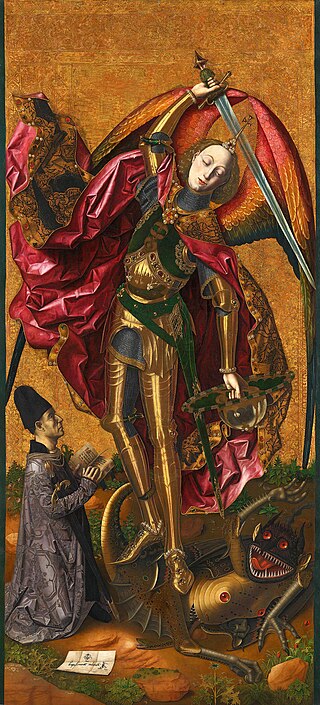
Bartolomé Bermejo was a Spanish painter who adopted Flemish painting techniques and conventions. Born in Cordoba, he is known for his work in the Crown of Aragon, including the Principality of Catalonia and the Kingdom of Valencia. His real name was Bartolomé de Cárdenas: the name Bermejo, which means auburn in Spanish, possibly relates to his hair colour. Bermejo may relate also to his surname, Cárdenas; Cardeno means purplish. He signs himself sometimes as "Bartolomeus Rubeus" meaning possibly "Bartholomew the Redhead".

Pedro de Orrente was a Spanish painter of the early Baroque period who became one of the first artists in that part of Spain to paint in a Naturalistic style.

Friar Juan Bautista Maíno, or Mayno was a Spanish Baroque painter.
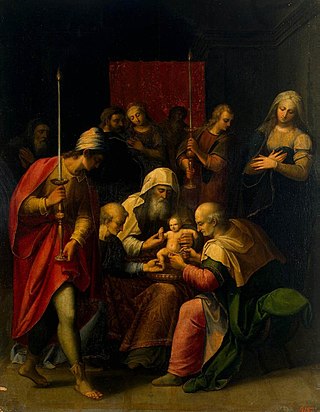
Luis de Carvajal was a Spanish painter of the Renaissance period.
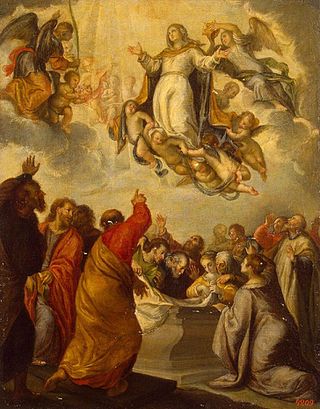
Francisco Camilo was a Spanish painter, the son of an Italian immigrant who had settled in Madrid. When his father died, his mother remarried, and Camilo became the stepson of the painter Pedro de las Cuevas.

The monastery of Santo Domingo Real, located in the city of Toledo, in Castile-La Mancha, Spain, is a convent founded in 1364 by the noblewoman Inés García de Meneses, daughter of García Suárez de Meneses and María Fernández Barroso, after being widowed by Sancho de Velasco.

The Church of St Leocadia is a medieval church located in Toledo, in Castile-La Mancha, Spain.

Saint Sebastian, or Martyrdom of Saint Sebastian is an autograph work by the famed artist Doménikos Theotokópoulos, commonly known as El Greco. It shows the Martyred Saint in an atypical kneeling posture which has led some scholars to believe it to be a compositional quotation of various works by other great masters whom the artist admired. The painting is currently on display in the Palencia Cathedral.

The Santo Domingo el Antiguo Altarpiece is a 1577-1579 altarpiece by El Greco, painted for the Monastery of Santo Domingo el Antiguo in Toledo, Spain. The artist had just arrived in Spain and this was his first major commission there, gained thanks to Diego de Castilla, who he had met in Rome.

Mateo Gilarte was a Spanish Baroque painter.
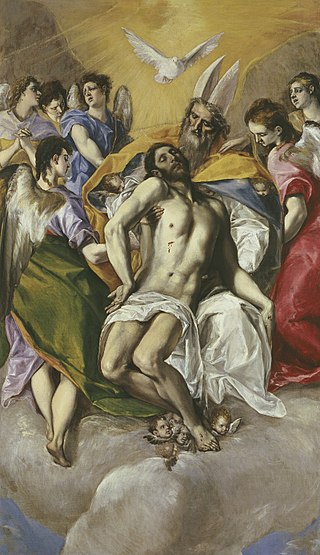
Holy Trinity is a c.1577–1579 oil on canvas painting by El Greco, one of nine works he produced for the Convent of Santo Domingo el Antiguo (Toledo). Ferdinand VII of Spain acquired it from the sculptor Valeriano Salvatierra in 1832 and it now hangs in the Prado Museum in Madrid.

The Arrabal of Saint Martin was a medieval arrabal (neighborhood) that sat outside the Christian Walls of Madrid. It was located around the location of the current Plaza of San Martín, and occupied the space between Calle del Arenal, the Plaza de las Descalzas, Plaza del Callao, and Calle de las Navas de Tolosa. It grew as a population center around the Monastery of Saint Martin, neighboring San Martín was the Arrabal of San Ginés, and both were absorbed by the growth of the city in the 17th century.
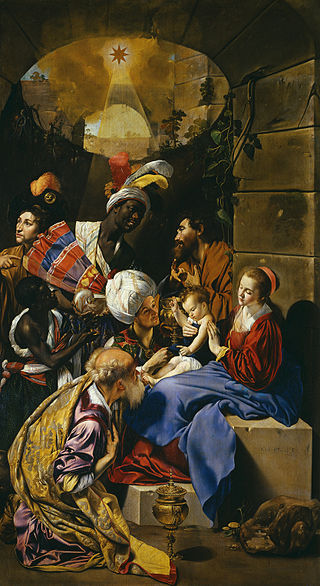
The Adoration of the Magi or La Adoracion de los Reyes Magos is a painting by Juan Bautista Maíno in the Museo del Prado, in Madrid.




















